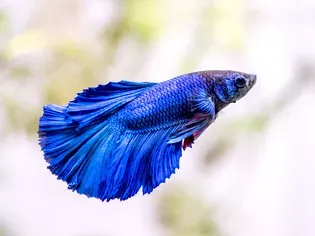Betta (Siamese Fishing Fish): Fish Species Profile
Updated on 04/26/24

Betta Fish: A Comprehensive Guide to the Vibrant Siamese Fighters
Introduction
Betta fish, also known as Siamese fighting fish, are renowned for their captivating appearance and aggressive nature. These vibrant creatures have captured the hearts of aquarium enthusiasts worldwide, making them one of the most popular freshwater fish species. In this blog post, we delve into the fascinating world of Betta fish, exploring their origins, behavior, care requirements, and their cultural significance.
Origins and History
Betta fish are native to the shallow waters of Southeast Asia, primarily in Thailand. They are descended from the wild Betta splendens, a small, brightly colored fish that has been a staple in rice paddies and canals for centuries. The fighting abilities of these fish were first discovered by Thai villagers, who began organizing contests between them as a form of entertainment.
Physical Appearance
Betta fish are known for their striking and diverse physical appearance. They come in a vast array of colors, including red, blue, green, yellow, and even iridescent shades. The signature feature of male Betta fish is their elaborate and flowing fins, which are often longer and more vibrant than those of females. Their bodies are typically elongated and streamlined, with a characteristic "hump" on their back.
Behavior
As their name suggests, Betta fish are known for their aggressive nature, particularly toward other males. This is attributed to their territorial behavior and the need to establish dominance within their environment. When two male Betta fish encounter each other, they will typically engage in an elaborate "dance" of flared gills and fins, attempting to intimidate one another. If this display is unsuccessful, a heated battle may ensue.
However, Betta fish can also be peaceful and curious when kept in isolation. They are often seen exploring their environment, interacting with plants and other non-threatening inhabitants of their tank.
Care Requirements
Providing proper care for Betta fish is crucial for their health and well-being. Here are some essential guidelines:
* Tank Size: Betta fish require a minimum tank size of 5 gallons, but larger tanks are preferred.
* Water Conditions: They thrive in warm water with a temperature range of 75-80°F (24-27°C) and a pH between 6.0 and 8.0.
* Filtration: A reliable filtration system is necessary to maintain water quality and remove waste.
* Plants and Decor: Live plants and artificial decorations provide hiding places and stimulate the fish's natural environment.
* Food: Betta fish are primarily carnivores and enjoy a diet of live or frozen foods such as brine shrimp, bloodworms, and small insects.
Cultural Significance
Betta fish have played a significant cultural role in Thailand and other Southeast Asian countries. Their unique appearance and fighting abilities have made them a popular subject of art, literature, and even folklore. In some cultures, Betta fish are believed to bring good luck and prosperity to their owners.
Examples of Different Types of Betta Fish
The Betta splendens species exhibits a wide range of variations in coloration and fin shape. Here are a few notable examples:
* Veiltail Betta: This variety is known for its flowing, trailing fins that resemble a veil.
* Double Tail Betta: As the name suggests, these Betta fish have two distinct tail fins that spread out like a fan.
* Halfmoon Betta: The Halfmoon Betta has a rounded, 180-degree tail fin that resembles a half moon.
* Delta Tail Betta: The Delta Tail Betta features a triangular-shaped tail fin with sharp points.
* plakat betta: This type of betta has short, rounded fins and a stockier body, resembling the wild Betta splendens.
Conclusion
Betta fish are captivating creatures that bring beauty, vibrancy, and cultural significance to the aquarium hobby. Their unique physical appearance, aggressive nature, and diverse varieties have made them a beloved species among enthusiasts worldwide. By providing proper care and understanding their specific needs, you can enjoy the company of these fascinating fish for many years to come.
Explore More Pets

Freshwater Aquarium Filters
How to Deal With Cloudy Aquarium Water

Saltwater Aquarium Filters
How Do You Remove Chloramines From Tap Water?

Freshwater Aquariums & Habitat
Can I Keep My Koi Fish Inside?

Saltwater Aquariums & Habitat
14 Best Floating Plants for Your Aquarium

Freshwater Fish Health
How to Treat Ich on Freshwater Fish

Saltwater Fish Health
Fin Rot in Aquarium Fish

Freshwater Aquarium Filters
How to Do Aquarium Water Changes

Saltwater Fish Health
How Do Fish Get Parasites?